Democratic Republic Congo - 3 days Kinshasa
The immigration at the port of Kinshasa was unexpectedly comfortable. I came with the canoe from Brazzaville across the river and the lady from the DRC immigration department wearing the blue DGM raincoat brought me through the procedure. It was a very rainy day, but I'm glad to even be here as rainy days can easily last for a few days in the Congos and when that happens, no canoe will drive across the river.
Not many understand why someone wants to visit the Congo’s and even more, even fewer would understand why someone wants to visit the « problem brother » of the two Congos – the DRC.
The DRC is the so-called ugly, corrupt gangster country of Africa always stuck in conflicts with rebel groups and spreading viruses like the recent outbreak of Ebola.
But the DRC is a big country and the conflicts are mainly in the very east. Therefore the capital Kinshasa is very far away with it's location in the very west of the country.
But the DRC is a big country and the conflicts are mainly in the very east. Therefore the capital Kinshasa is very far away with it's location in the very west of the country.
Are there some things to see in Kinshasa?
Nevertheless, very few people really want to go to the DRC (or Kinshasa) because it's claimed there is not much to see there. I didn't want to believe that and my curiosity was even greater to spend a few days in the country.Although, the biggest obstacle to get here is solely about how to obtain the DRC visa.
For example, Kinshasa also has spectacular buildings, there are some interesting monuments and the atmosphere is, like in every country, completely different from other countries. Only compared to the Republic Congo it's completely unique and this is why it makes it very interesting to see the area around Kinshasa.
Also, the biggest airport is in Kinshasa and from there it's perfect to continue the journey with a direct flight to Gabon.
From the harbor and immigration, when coming with the canoe across the river, all the way to the hotel took me only 10 minutes. Even though there is normally an abnormal amount of traffic.
For example, Kinshasa also has spectacular buildings, there are some interesting monuments and the atmosphere is, like in every country, completely different from other countries. Only compared to the Republic Congo it's completely unique and this is why it makes it very interesting to see the area around Kinshasa.
Also, the biggest airport is in Kinshasa and from there it's perfect to continue the journey with a direct flight to Gabon.
Day 1 – First impression: This is not a nice city, but interesting!
Probably all the rain made my first impression of Kinshasa so bad.From the harbor and immigration, when coming with the canoe across the river, all the way to the hotel took me only 10 minutes. Even though there is normally an abnormal amount of traffic.
The Hotel Kirikou is located in the middle of Kinshasa and makes a very good impression inside the hotel. It was in a rather shabby office or residential building, but compared to other buildings in Kinshasa the building itself was very well maintained.
Map of Kinshasa

Expensive food
After arriving at the hotel it was already time for dinner and I walked around aimlessly towards the main street to find a restaurant. There are actually some restaurants that make a useful impression, but the food is extremely expensive.A plate with fries and a chicken leg from a Lebanese fast food restaurant costs 17 dollars.
Safety in Kinshasa
At every corner along the main roads, there stands a bunch of police and soldiers carrying their AK47s. They are definitely not for fun as they were looking all seriously mean.But I understand their worries - in a country that is covered with rebel groups, something unforeseen can come up every second. Nevertheless, I didn't feel comfortable when passing them. I'm sure, they were looking at me trying to invent something for making some small money.
Walking around randomly along the flooded, dirty streets
In Kinshasa, there are the big main roads that are very well maintained and solidly built.Left and right of these big main roads are the streets full of dirt and mud, it is often not possible to get through because they are so flooded. Even by walking, it's almost like a hike. And the best: that is not an exceptional situation, but a permanent condition.
The roads are in an absolutely miserable condition or rather they are not roads but mud heaps.
The roads are in an absolutely miserable condition or rather they are not roads but mud heaps.
So to speak the main roads are on the right and the muddy roads on the left. It is not that the area were poor slums, but these districts on this side are normal residential areas, the biggest markets and most shopping facilities of the whole DRC.
These extremely large shopping districts, which extend over dozens of square kilometers, are the economic pulse of the country and it was surprising to see the business districts in such a state.
While walking through and taking pictures I was often approached in a friendly and supportive manner:
Yes, please, take photos of the muddy streets, the outside world should see how we are denied good conditions to live and make business! Thank you! Thank you!
Walking along the Main Street "Boulevard Du 30 Juin"
The main road is well built and also are the buildings on the left and right.It has many shopping facilities in the form of well-equipped large supermarkets. However, there are not many of this kind in the whole country.
Along this main street are all the important banks and ministries, these sources of income keep the country (and especially the corrupt government) "alive".
Photographers take pictures of people at "Place De La Gare Centrale"
I knew here in Kinshasa I have to be on my guard when I take pictures because they are not allowed.Arriving at the "Place de la Gare", it was astonishing to see half a dozen photographers with SLR-cameras waiting for customers (passers-by) to take pictures of them in front of the monument and to provide the photo print for a small change.
Somehow it did not fit into the photography policy of the country.
View from the highest building of the country "Building ex-Sozacom"
Not far from the train station was the highest building in the whole country, the ex-Sozacom building.I asked at the reception if I could go up to the roof to see Kinshasa from above. After the first denial and that it is not possible, they loosened up a bit and asked the janitor.
He said that it is basically possible for a small "tip". We took the lift to floor 20 and from there we changed to the stairs to climb the next 10 floors on foot.
Afterward, the height was enough for me to take pictures and enjoy the view.
Day 2 – Kinshasa is huge and ugly, but interesting
Today's program included a roundabout, the Palace of Justice, Academy Des Beaux-Arts, the station and just the streets and watching it's people.Walking to the "Rond-Point Forescom"
One of the most important monuments of the country is located on this roundabout in the middle of Kinshasa. It is supposed to celebrate independence.To the area with the "Palais de Justice" and the "Palais de Nations"
The way here is very far on foot, so I took a motorbike taxi and realized that I should probably avoid that in Kinshasa.Many of the drivers are always drunk and I noticed that. The motorcyclist drove like a hangman between the cars, on one occasion I had to stop him from driving between the cars because it simply became just too dangerous. And I don't want to get injured in THIS country.
In this area are all the ministries and many embassies. Even though the area is beautiful and you can see the money that has been invested in the buildings.
In this area are all the ministries and many embassies. Even though the area is beautiful and you can see the money that has been invested in the buildings.
Although, it is not "tourist-friendly" and guards clearly show it to people like me who are walking around with cameras.
The area around "Cathédrale Notre-Dame Du Congo"
This area is far outside the city center of Kinshasa, in the area called Lingwala.The church is huge, even the largest in the DRC and can accommodate almost 1000 people. The seats are wooden and the interior of the church is very spacious for a church in this part of the world.
I was there around noon when it was hot as an oven. Outside were hours of painting the church.
Lunch in the streets of "Lingwala"
It was already time for lunch and even there were many many places to have lunch, I simply did not trust most of the food they offered.That's why I went to the restaurant which looked like a fake KFC.
To the "Academy Des Beaux-Arts"
The area is well secured and is an art school.Since it was a normal weekday, students have been practicing art, many of them will probably become good Congolese artists one day.
Students and lecturers are very friendly and happy about strangers who found their way here. They come up and ask many questions.
Throughout the area, various objects such as sculptures or Congolese carpentry and paintings were on display and practically all of them can be bought.
My intervention that I am not an expat but a tourist remained ineffective.
The currency had to be paid in Congolese Franc, but with an equivalent of 20 Euro, it was simply too much.
The museum is too expensive "National Museum of Congo"
My plan was to visit the national museum often the DRC. But when arriving there they asked for a horrible steep entrance fee:Residents entrance fee is 5 euros. For expats its 20 Euro.
My intervention that I am not an expat but a tourist remained ineffective.
We don't have prices for tourists. Tourists are the same as NGO and expats.
The currency had to be paid in Congolese Franc, but with an equivalent of 20 Euro, it was simply too much.
I asked for the price list but they "didn't have" one.
That's why I skipped seeing the interior of the huge building. But the street around the museum was nice to see as well.
When I look at such buildings I wonder if it was really necessary to build such palaces when a few hundred meters away people have to live in dirt and mud and have no roof over their heads.
But at least the name of the building contains the word "people".
A passer-by explained to me that the stadium is used for concerts as well as football matches and that there is only room for 80000 people, but up to 125000 people can be admitted.
Continue to the "Palais du Peuple"
Another grandiose building demonstrates that the DRC has inexhaustible financial resources.When I look at such buildings I wonder if it was really necessary to build such palaces when a few hundred meters away people have to live in dirt and mud and have no roof over their heads.
But at least the name of the building contains the word "people".
The impressive soccer stadium "Stade de Martyrs"
A walk further down the road of Boulevard Triomphal the stadium.A passer-by explained to me that the stadium is used for concerts as well as football matches and that there is only room for 80000 people, but up to 125000 people can be admitted.
Back to Kinshasa City via "Grand marché de Kinshasa"
After the stadium, I walked the next best main road towards the city center according to Google maps.The streets are lasting forever when walking and the further I walked into the "Centre Ville" the more chaotic it became and the number of crowds increased.
12 million people live in Kinshasa. So it's no surprise that many people are visible on the streets.
On the way back I wanted to visit the biggest market of Kinshasa to end the day.
12 million people live in Kinshasa. So it's no surprise that many people are visible on the streets.
The market was too much, I've never been to such a full market!
(The images above do not show the market as it is absolutely prohibited to take images there.)On the way back I wanted to visit the biggest market of Kinshasa to end the day.
Had I known beforehand what chaos it was in there, I would have skipped the visit. The market has about 15'000 sellers - that is a hell of a lot!
According to the number of sellers, there is also an exponential amount of buyers and this was just too much for me. Too many people here!
I would not recommend going to the market, as there are many thieves and there is ZERO space to walk properly.
Once in the middle of the market area, there is no quick way out and there is no freedom of movement. There are simply too many people and everyone is pushing and shoving and the ground is full of mud everywhere. When panic breaks out here, people literally get stomped to death!
According to the number of sellers, there is also an exponential amount of buyers and this was just too much for me. Too many people here!
I would not recommend going to the market, as there are many thieves and there is ZERO space to walk properly.
Once in the middle of the market area, there is no quick way out and there is no freedom of movement. There are simply too many people and everyone is pushing and shoving and the ground is full of mud everywhere. When panic breaks out here, people literally get stomped to death!
This was definitely the most crowded market I have ever seen. Rarely have I felt so uncomfortable in any other market on the planet.
Day 3 – Outside Kinshasa and then to the Airport (an adventure)
The day before yesterday I was informed that my flight from Kinshasa to Gabon will be delayed for two days (Yes, 48 hours)!That was totally unfavorable because I would miss the onward flight from Gabon. Therefore I had to find an alternative flight to be able to fly to Gabon today. Luckily Turkish Airlines had free seats, although later in the evening but that did not matter.
Because I have an alternative flight late in the evening I could "enjoy" the DRC a bit more.
Because I have an alternative flight late in the evening I could "enjoy" the DRC a bit more.
With the bus to the "Chez TinTin" at the Congo River
From Kinshasa there are a lot of minibusses and with one of them, I was able to drive west to have lunch at the Congo River.I have already seen the Congo River from the Republic Congo and it was impressive.
To get there I had to change buses twice but it was worth it. The trip took 1 hour each way.
Chez TinTin is a restaurant directly at the Congo River. From there is a perfect view of the river while having lunch.
Today the restaurant had two menus to choose from, one was chicken and the other goat. Since goat was apparently the most popular food in the Congo, I wanted to try it because I never had goat before.
To get there I had to change buses twice but it was worth it. The trip took 1 hour each way.
Chez TinTin is a restaurant directly at the Congo River. From there is a perfect view of the river while having lunch.
Today the restaurant had two menus to choose from, one was chicken and the other goat. Since goat was apparently the most popular food in the Congo, I wanted to try it because I never had goat before.
The goat was slaughtered on the spot and the meat was cut into bite-sized portions. Afterward, they are wrapped in leaves in the Congolese way, seasoned and grilled over charcoal. After about 30 minutes the pieces are ready and served with chips.
Goat meat is a bit tough, but the food was very fine.
The river is flooded these days and half of the restaurant "Chez Tintin" was underwater.
The river is flooded these days and half of the restaurant "Chez Tintin" was underwater.
Nevertheless, the view of the river was great.
Departure to Gabon via Kinshasa Airport – Traffic Nightmare!
The hotel arranged a taxi for me to the airport for 40 dollars. At first, I couldn't believe that it was so expensive, but apparently, this is the normal price.Also, under normal circumstances, the trip takes 90 minutes. In my case, it was almost 3 hours. On google maps, it doesn't look like that, but the traffic is brutal.
I thought I could do it with public transport, but in retrospect, I'm glad I didn't try that. I probably would never have arrived at the airport.
I thought I could do it with public transport, but in retrospect, I'm glad I didn't try that. I probably would never have arrived at the airport.
The way to the airport. It looks like an exodus!
By the end of the working day, everyone wanted to go home. Everyone comes to Kinshasa from far away to work and leaves in the evening.The whole thing resembles a migration of people. Or as if a war has broken out.
Since there are no good transport connections and the train lines have been destroyed, thousands of people walk along the road.
To round off the whole experience, the police are regularly standing by with AK47s and shotguns to check and punish traffic violations. That doesn't make it any faster for all the people to get ahead.
There was so much to see on the way to the airport, including watching a bus in the convoy hit the car of a diplomat.
There was so much to see on the way to the airport, including watching a bus in the convoy hit the car of a diplomat.
The resulting turmoil in this part of Africa is interesting to watch. The bus driver will probably never drive a bus again.
The amount can only be paid in cash at a specially designated counter and I received a receipt. So it was an official procedure. The receipt has to be shown before checking in.
The Kinshasa Airport "Ndjili" is small
The airport itself is relatively new but small, it is clean and has A/C but no Wifi. There are two restaurants and a coffee without milk costs 5 dollars. Yes, the prices for food are high in DRC.Everybody has to pay a mandatory departure tax of 55 dollars
What nobody told me was that every passenger has to pay a $55 "departure tax".The amount can only be paid in cash at a specially designated counter and I received a receipt. So it was an official procedure. The receipt has to be shown before checking in.
Such taxes are normally included in the ticket price, but not in the DRC. So without paying the 55 dollars there is no departure. I have seen people trying to withdraw money from the ATM but their credit card did not work. I'm glad I had the money in cash with me.
Now wait in the boarding area and wait for my flight to Gabon. According to the display this flight should be on time.
















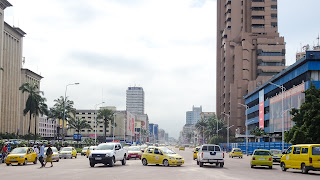








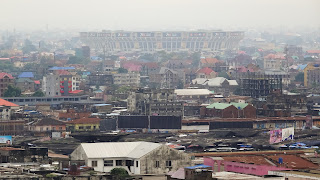


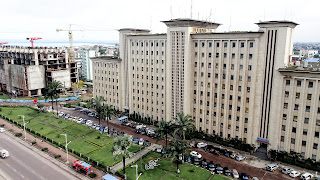


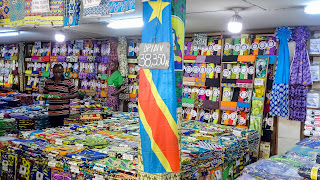









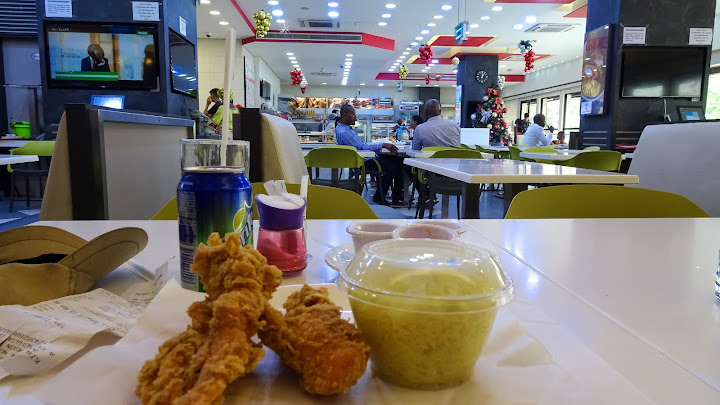



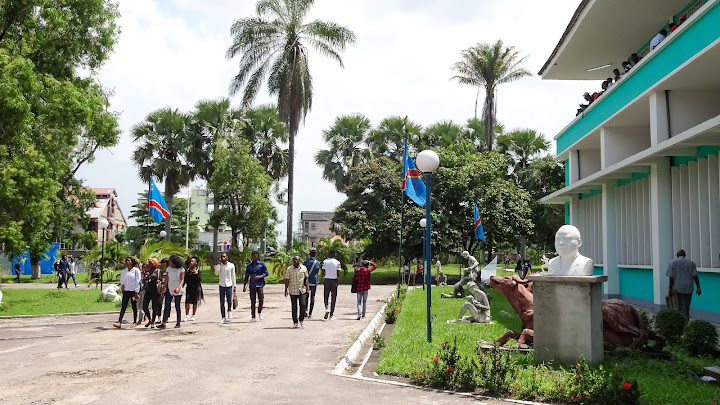





















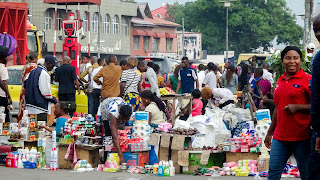










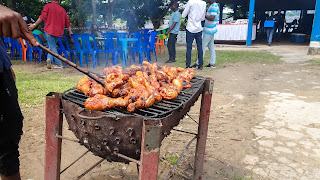







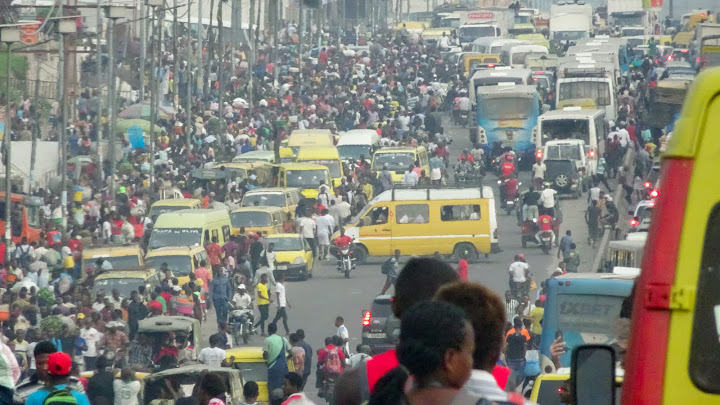
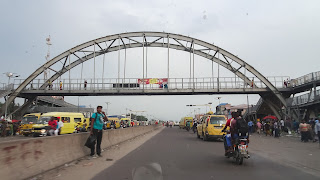

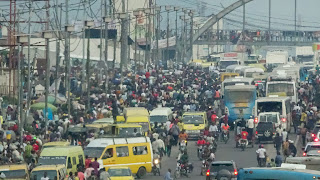
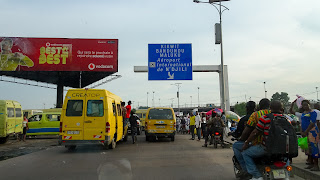



Amazing post, did you ever get threatened or asked for a bribe?
ReplyDeleteHello Rohan. There was one strange occasion. One guy in a suit stopped me in the open public street saying he is from the police and showed me some kind of ID. He wanted to see my money and "check if I have any fake money". He was sweating and a bit nervous so I guess he was not from the police, but I was surprised that he didn't ask for a bribe at the end. But that was the only uncomfortable situation in the DRC.
Deletethanks for posting this, super cool. Amazing photos!
ReplyDeleteEnjoyed the post but I would have liked more to see some discussion of why things are the way they are there, why things are very expensive even for residents, public services are not maintained, etc. What about the ownership of wealth in DRC? Is the rest of the world’s outside influence making things extremely expensive? Thoughts from locals about politics?
ReplyDeleteThanks, Sven, for these nice and rare impressions from Kinshasa.
ReplyDeleteFor such a short stay you've seen a lot given the various difficulties. I've been in Kinshasa for a week now and am still puzzled by the contrasts. Western style (and prize) restaurants, supermarkets and shopping malls not far from extremely primitive villages without electricity is just one example of many.
Clearly the conditions are not such that tourists feel welcome and it is fair to say, that there are essentially no tourists, only family visitors and professional travelers who sometimes go sightseeing.
Happy traveling